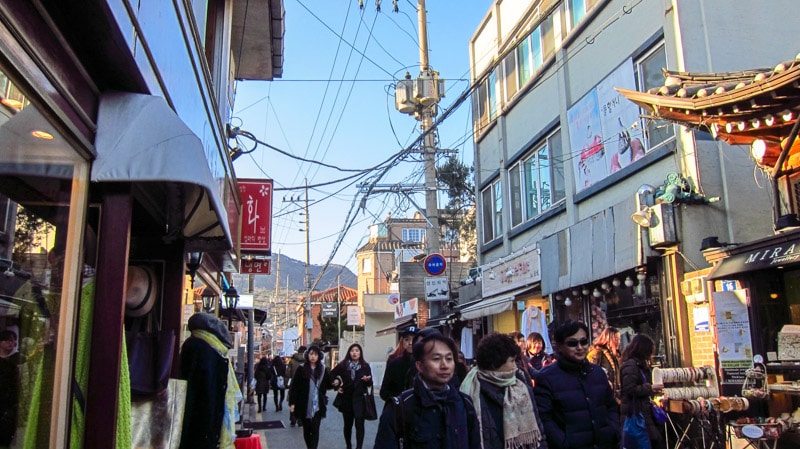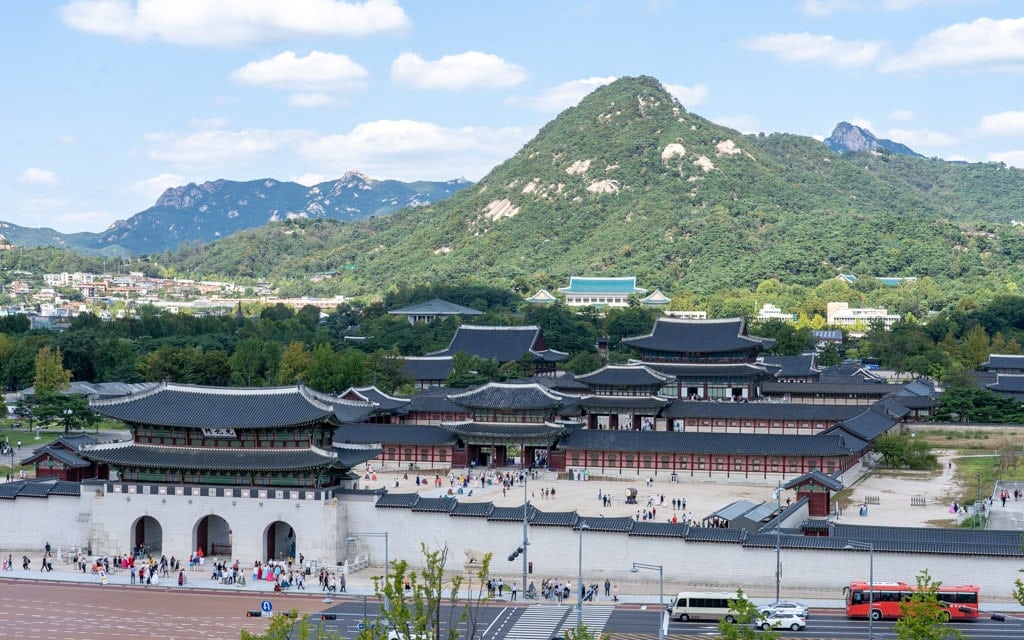
Gyeongbokgung Palace, located north of Gwanghwamun Square, is one of the most iconic sights in all of Korea thanks to its long and storied history. Construction on Gyeongbokgung Palace was completed in 1395 at the beginning of the Joseon Dynasty during the reign of King Taejo. Gyeongbokgung, which means “palace greatly blessed by Heaven,” was built in the heart of Seoul surrounded by Mount Bugaksan and Mount Namsan.
Free guided tours in English are available at 11:00, 13:00, and 15:30.
Changing of the Guard ceremony takes place at the top of every hour from 11:00 to 15:00.
This palace is included with the Integrated Ticket of Palaces.
Closed on Tuesdays.
In 1394, during the early days of the Joseon Dynasty, the capital of Korea was moved from Kaesong, in modern day North Korea, to Seoul, known then as Hanyang. When the capital was moved, a new palace was required and built.
When construction was completed, Gyeongbokgung Palace became the heart of the capital of Korea along with the head of state of the Joseon Dynasty.
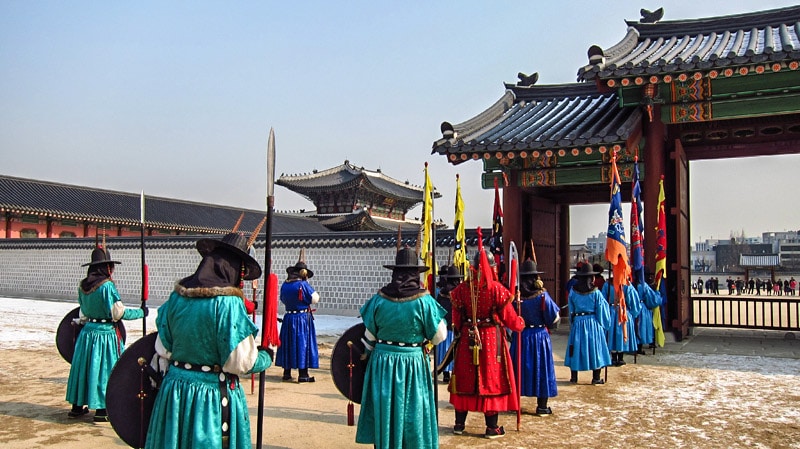
Expanded over time, Gyeongbokgung was the center of power during the Joseon Dynasty until the Japanese invasion of 1592-1598. During this time, the palace was destroyed by fire and left in ashes. One fire was started by slaves trying to destroy legal status records.
It was decided that Changdeokgung Palace would be rebuilt and serve as the new main royal residence.
The ruins of Gyeongbokgung were abandoned for the next 270 years
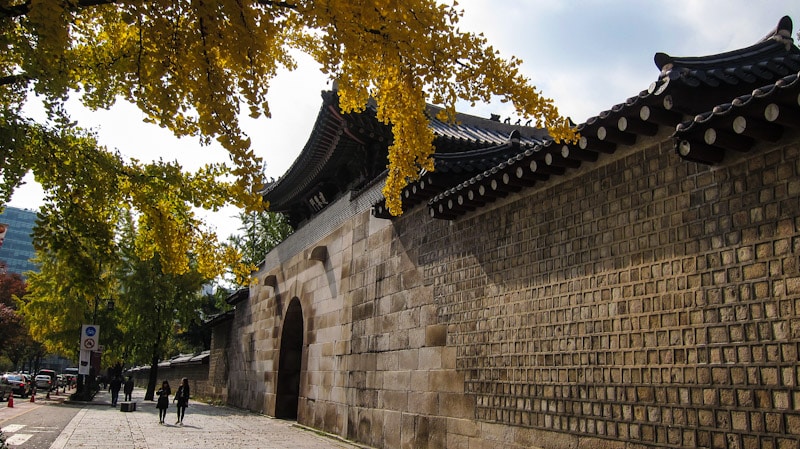
In 1868, Gyeongbokgung was rebuilt and restored as an icon of Korea with help from Heungseon Daewongun, also known as Prince Regent. The royal residence was built differently as is it stood 270 years earlier. Gyeongbokgung Palace architecture skillfully combined ancient Chinese architecture principles with Joseon Dynasty tradition. Over 330 buildings were constructed in the area.
The new construction was the size of a small city taking up about 410,000 square meters (4,414,000 square feet). The palace at the time was a self functioning unit comparable to China’s Forbidden City.
During the Japanese occupation, Gyeongbokgung Palace was was mostly dismantled and destroyed, including Gwanghwamun Gate and nearly all other buildings that were rebuilt in 1867. All but ten buildings were demolished.
In 1916, the Japanese built their large General Government building north of Gwanghwamun Gate. This building, a sign of Japanese imperialism and a blow to the pride of Korea, stood until 1995.
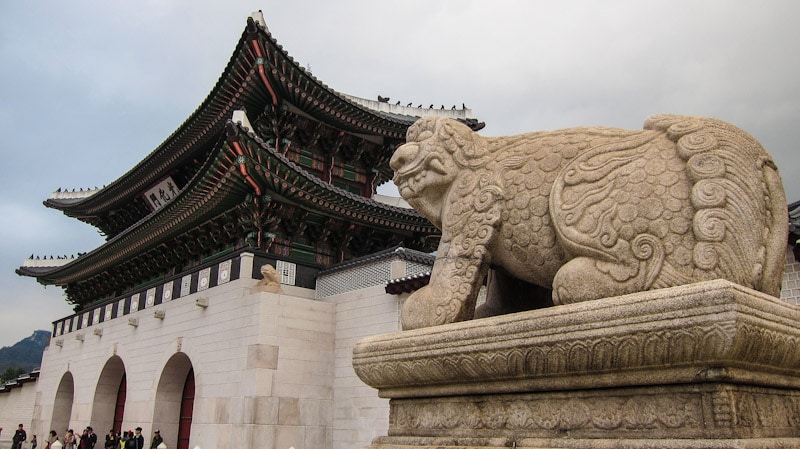
With the war long over, the government of Korea has been trying to restore it to its former glory. Such steps have been taken such as restoring Gwanghwamun Gate and Heungnyemun Gate to their original state.
The restoration project by the South Korean government is scheduled to take at least another 20 years to complete.
Gyeongbokgung Palace Facts
- The palace was first constructed in 1395 at the early days of the Joseon Dynasty.
- Taejo was the king during the original construction. He reigned from 1392 to 1398.
- Gyeongbokgung was the main palace of the capital city and the largest of the Five Grand Palaces in Seoul.
- The name Gyeongbok means “Greatly Blessed by Heaven.”
- The grounds were expanded over the years during the reign of King Taejong and King Sejong the Great.
- The palace was abandoned for almost 300 years after being destroyed by a fire during the Japanese invasion of 1592.
- The palace was reconstructed in 1867, once again making it an icon of Seoul.
- On October 8, 1895, Empress Myeongseong, the wife of Emperor Gojong, was assassinated by the Japanese. Gojong, along with the royal family, never returned to the palace.
- During the Japanese occupation of Korea, almost all of the palace buildings were dismantled or destroyed.
- In 1926, the Japanese General Government Building was built in front of Geunjeongjeon Hall.
- Other buildings were destroyed during the Korean War from 1950-1953.
- Only a few buildings from the 19th century survived both the Japanese occupation and the Korean War. The surviving buildings include are Geunjeongjeon Hall, Gyeonghoeru Pavilion, and Hyangwonjeong Pavilion.
- Restoration work began in 1989.
- In 1995, the Japanese General Government Building was demolished.
- Today, there are two museums located on the grounds of the palace. They are the National Folk Museum of Korea and the National Palace Museum of Korea.
- As of 2014, less than half of the buildings have been restored to their former glory.
What to see at Gyeongbokgung Palace
Gangnyeongjeon Hall
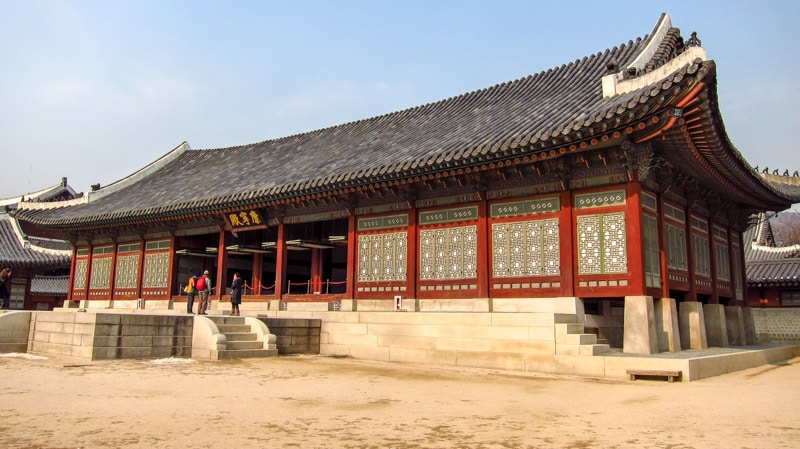
Gangnyeongjeon Hall, named after the virtue of health, served as the living quarters and resting area for the king. It was first constructed in 1395. The king also met with his entourage here to discus daily activities, state affairs, and office duties.
Gangnyeongjeon Hall was built in a checkerboard pattern of fourteen rectangular chambers and corridors. The king would use the central chamber. Court attendants who assisted, served, and protected the king resided in the other chambers.
A woldae, or elevated stone platform, is located in front of the structure.
Over the years, the building was twice destroyed. It was first demolished by the Japanese in 1592 during their invasion of Korea. It was then destroyed by a fire in 1867. Both times, the hall was rebuilt.
The Japanese, who occupied Korea between 1910 and 1945, decided to disassemble the building, and nearby Gyotaejeon Hall. With these materials, the Japanese rebuilt Huijeongdang Hall at Changdeokgung Palace which was burnt down by a fire in 1917.
Between 1994 and 1995, the current hall as seen today was rebuilt and restored to its original design and features.
Geoncheonggung Residence
Geoncheonggung Residence was built by King Gojong for the purpose of being politically independent of his father, Heungseon Daewongun.
The residence was constructed in 1873, five years after Gyeongbokgung Palace was built.
Geoncheonggung included quarters with several bedrooms for the king and queen. Gojong enjoyed spending much of his time here with his queen, Empress Myeongseong.
Jangandang Hall was where the king resided while Gonnyeonghap Hall was the residence of the queen. A library was built behind Jangandang Hall.
Empress Myeongseong was assassinated at the residence inside Okhoru Pavilion on October 8, 1895. She was killed by the Japanese as they considered her an obstacle in the expansion of their empire. After the assassination, Gojong left and never returned to the building that he once occupied since 1888.
In 1909, the Japanese government, who occupied Korea at the time, demolished this area.
In 2007, after years of restoration and renovations, the area reopened with its former design.
Geunjeongjeon Hall
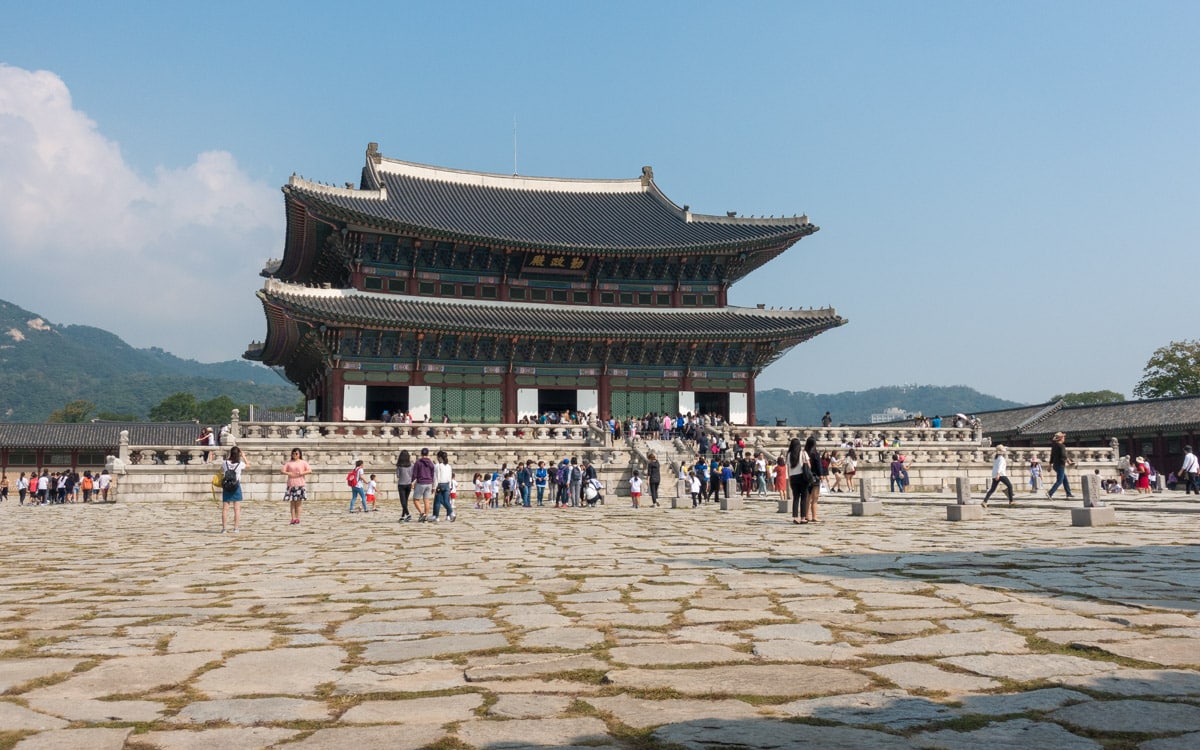
Geunjeongjeon Hall is the main throne hall of Gyeongbokgung Palace. Originally built in 1395, Geunjeongjeon is now the largest and most formal hall at the palace. The name translate to “all affairs will be properly managed if Your Majesty demonstrates diligence.”
Like many other buildings in Korea, the original hall was burnt down during the Japanese occupation in 1592.
The building seen today dates back to 1867, during the reconstruction of the palace. The building is constructed mostly of wood.
It was at this location where the king held meetings, handled state affairs, and held receptions for foreign visitors and dignitaries. Grand celebrations, such as coronation ceremonies of kings were also held here.
In front of the hall extends a grand courtyard with three footpaths running through the center. On these footpaths, there are two rows of markers which bear the rank of a court official.
Four times a month, civil and military officials would line up at their designated marker while the king sat on his throne inside the hall. The officials would sit on cushions made of different animal skins such as tiger or leopard. All officials would dress in full uniform, including the lowest ranking officials.
Gwanghwamun Gate
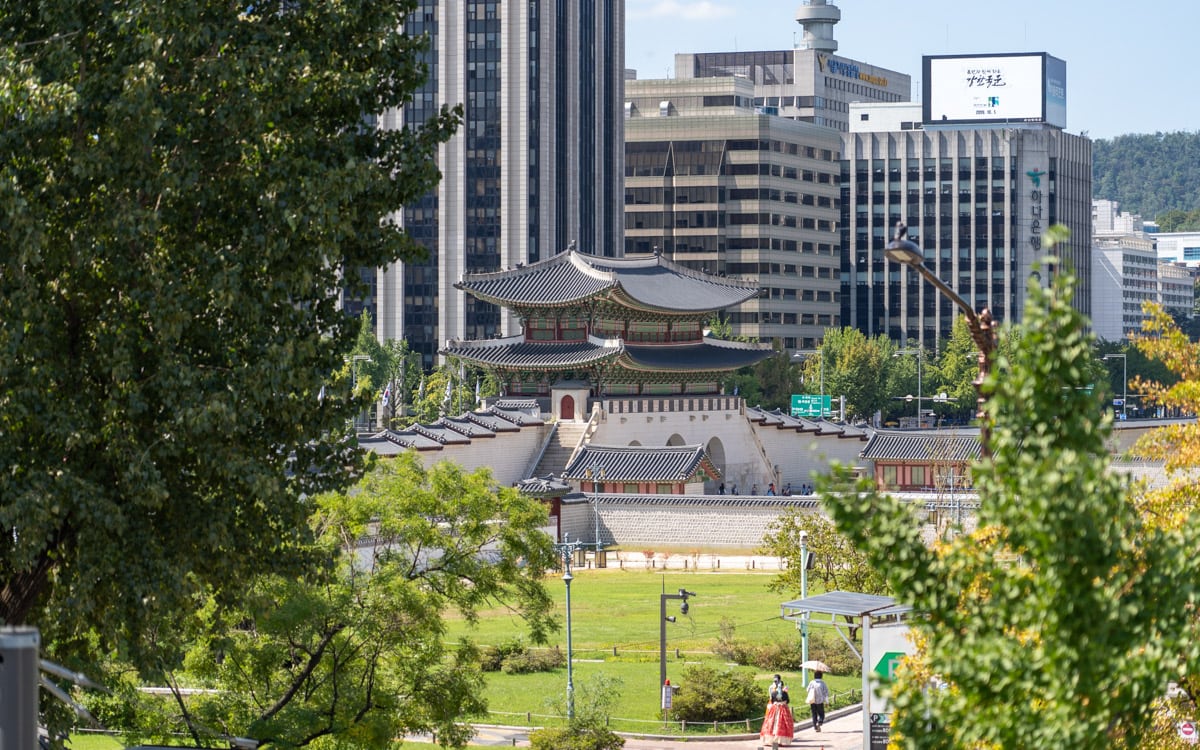
Gwanghwamun Gate is the imposing main gate of Gyeongbokgung Palace. The gate has been rebuilt many times over the years but remains an icon of Seoul.
Construction began in 1395 at the beginning of the Joseon dynasty. The gate quickly became one of the most important gates of the Joseon Dynasty since it guarded the main palace.
There are three other gates that can be found along the 2,404 meters (7,887 feet) of walls surrounding the palace. The other three gates are Sinmumun, Geonchunmun, and Yeongchumun.
Read more about Gwanghwamun Gate.
Gyeonghoeru Pavilion
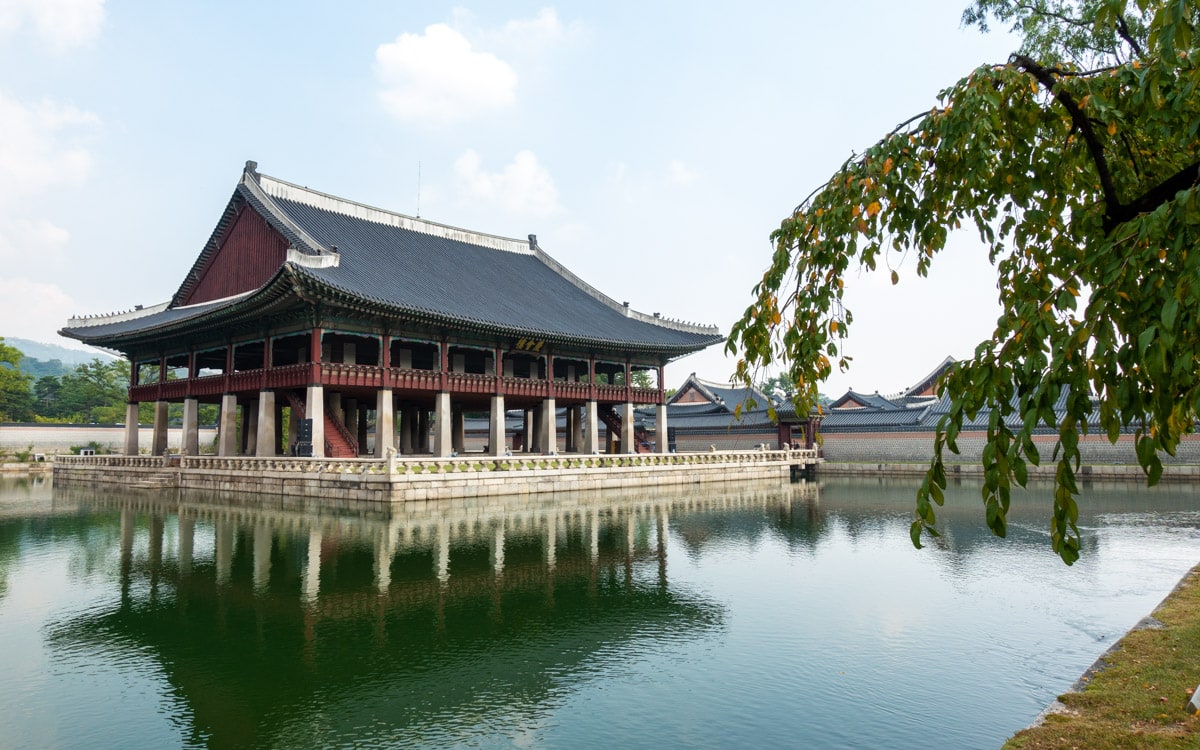
Located on a peaceful pond, Gyeonghoeru Pavilion treats visitors with some of the most beautiful views at Gyeongbokgung Palace. The pavilion was once used for entertainment when important foreign visitors visited the palace.
Read more about Gyeonghoeru Pavilion.
Gyotaejeon Hall and Amisan Garden
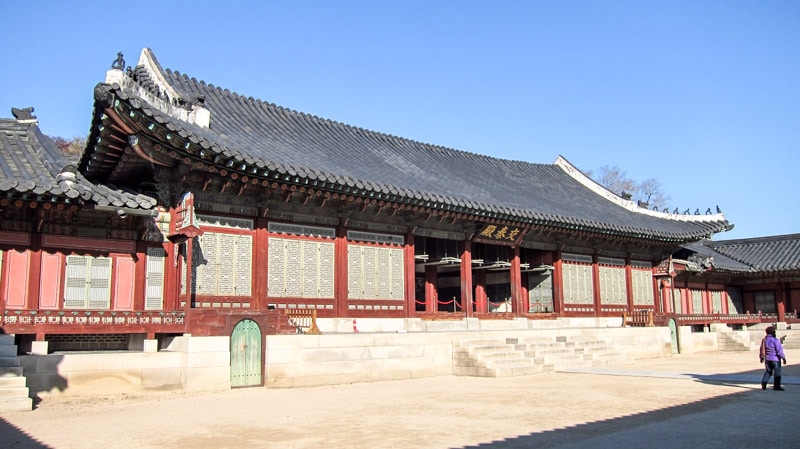
Gyotaejeon Hall, located behind Gangnyeongjeon Hall, was the main living quarters and resting area for the queen. The hall, which was built around 1440, served as the location where the queen oversaw the operation of the household at the palace.
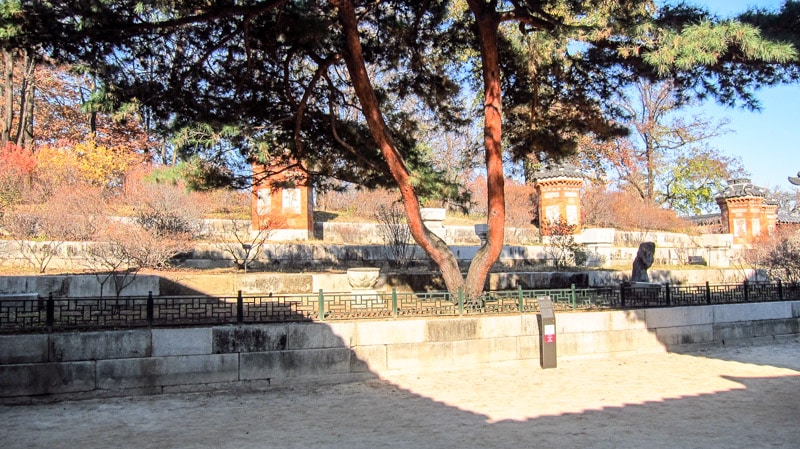
At the rear of Gyotaejeon Hall lies the garden of Amisan. This famous and beautiful garden features a terraced flower garden, decorated stonework, and four chimneys. These chimneys, hexagonal in design, were built around 1870 and feature decorative orange bricks and roof tiles.
Hamhwadang Hall and Jipgyeondang Hall
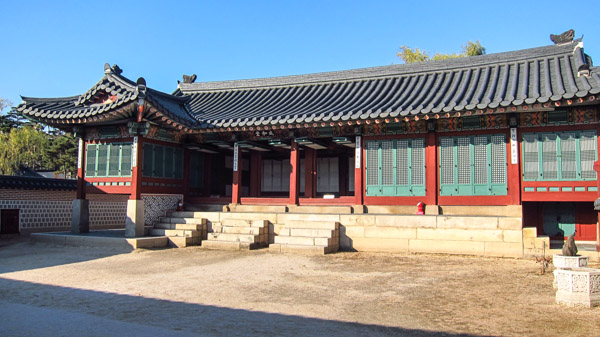
Hamhwadang Hall and Jipgyeondang Hall, located north of Gyotaejeon Hall, is where King Gojong met with officials and welcomed foreign envoys when he resided at Geoncheonggung Residence. The exact purposes of the buildings is not known
It was believed that these halls were used as living quarters for concubines and court ladies. These two halls are the only remaining in the area. They were saved and used as a museum by the Japanese during their occupation of Korea.
Hamhwadang Hall and Jipgyeongdang Hall are connected by a corridor which is a fine example of the once complex network of passageways of the original palace.
Hamwonjeon Hall
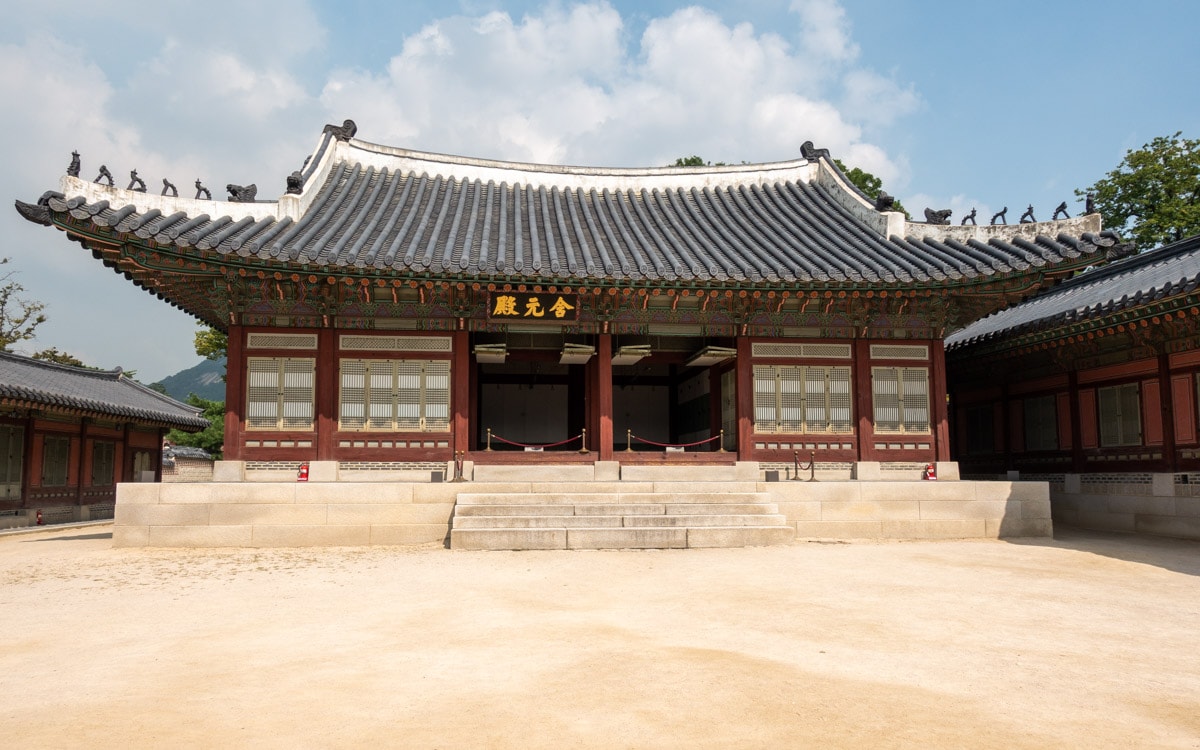
Hamwonjeon Hall, built during the reign of King Sejong, was believed to have been used as the location of many Buddhist events at Gyeongbokgung Palace.
Sejong was the fourth king of the Joseon Dynasty and ruled from 1418 unitl his death in 1450.
Hamwonjeon Hall has been damaged by fire and rebuilt many times throughout the years. The hall was last rebuilt in 1888.
In 1917, the hall was dismantled and its parts were used to rebuild Changdeokgung Palace.
As with Heumgyeonggak Pavilion, Hamwonjeon Hall was restored in 1995.
Heumgyeonggak Pavilion
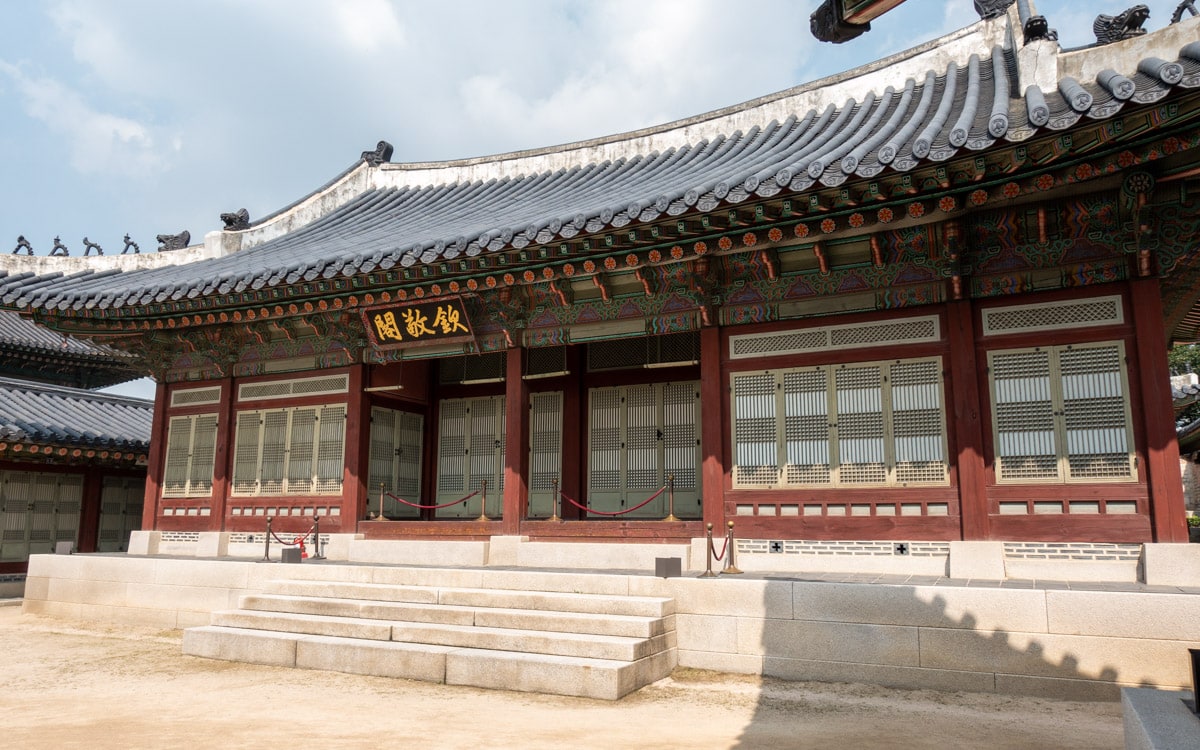
Heumgyeonggak Pavilion, built in 1438 during the reign of King Sejong, was used by the king for astronomical and agricultural observations and research. Heumgyeong means “respectful veneration of the ways of heaven.”
Heumgyeonggak Pavilion is located near Gangnyeongjeon Hall, which was the sleeping and resting quarters of the king. This location allowed the king easy access for observations and to track the movements of heavenly bodies.
Many of the inventions by King Sejong were installed here. Such inventions included a rain gauge, sundial, water clock, and celestial globes. A water clock known as ongnu was installed here in 1438.
Heumgyeonggak Pavilion was destroyed by a fire in 1563 during the eighth year of the reign of King Myeongjong.
Heumgyeonggak Pavilion, along with Hamwonjeon Hall, Gangnyeongjeon Hall, and Sajeongjeon Hall, was restored in 1995.
Heungnyemun Gate
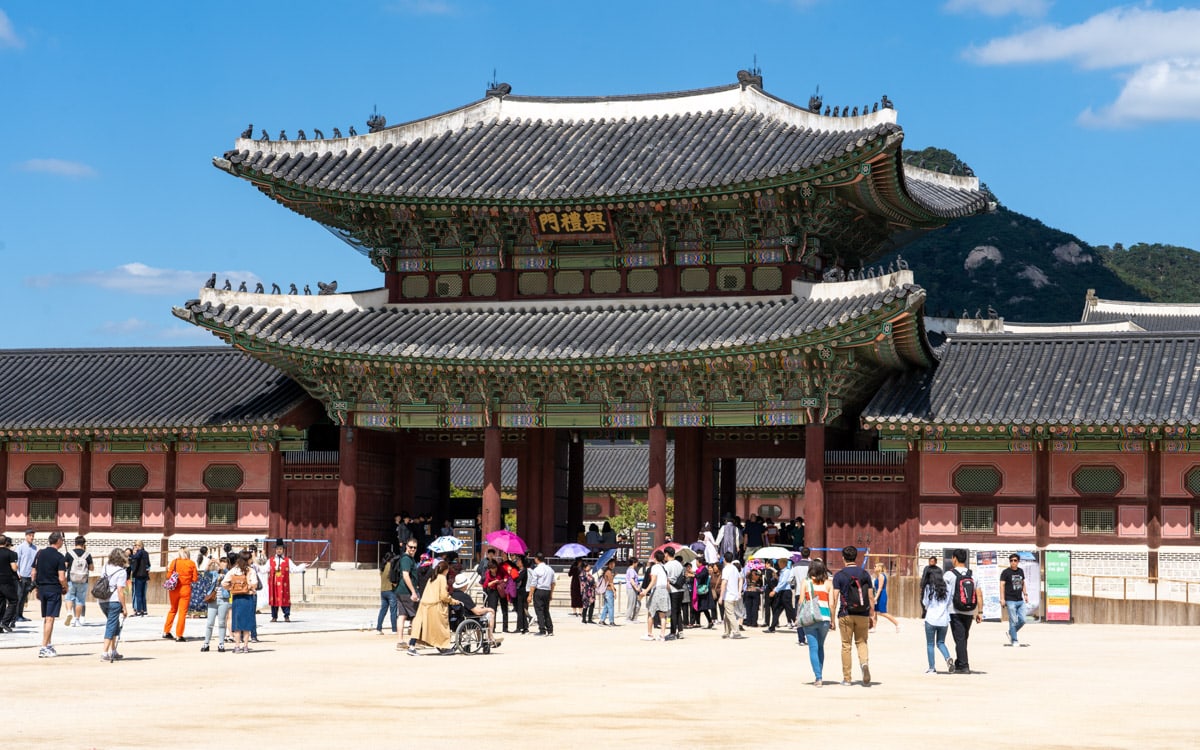
Heungnyemun Gate is the second inner gate into Gyeongbokgung Palace. The gate is located just past Gwanghwamun Gate, the main gate of the palace.
When originally built in 1426, the gate was known as Hongnyemun. It was not renamed to Heungnyemun until 1867 when Gyeongbokgung Palace was rebuilt under the orders of Prince Regent Heungseon Daewongun.
When the Japanese built the General Government Building here in 1926, Heungnyemun was removed along with most of the other buildings and structures found at the palace.
Between 1995 and 1996, the General Government Building was dismantled and removed in an effort to remove any trace of the Japanese occupation.
In 2001, Heungnyemun Gate, and its surrounding cloisters were rebuilt and restored to its original specifications.
Those who wish to pass through Heungnyemun must have a ticket to enter Gyeongbokgung Palace.
If you wish to take photos with guards, you can often find them stationed just outside the gate. If they are not there, you can always find them out front of Gwanghwamun Gate.
Hyangwonjeong Pavilion
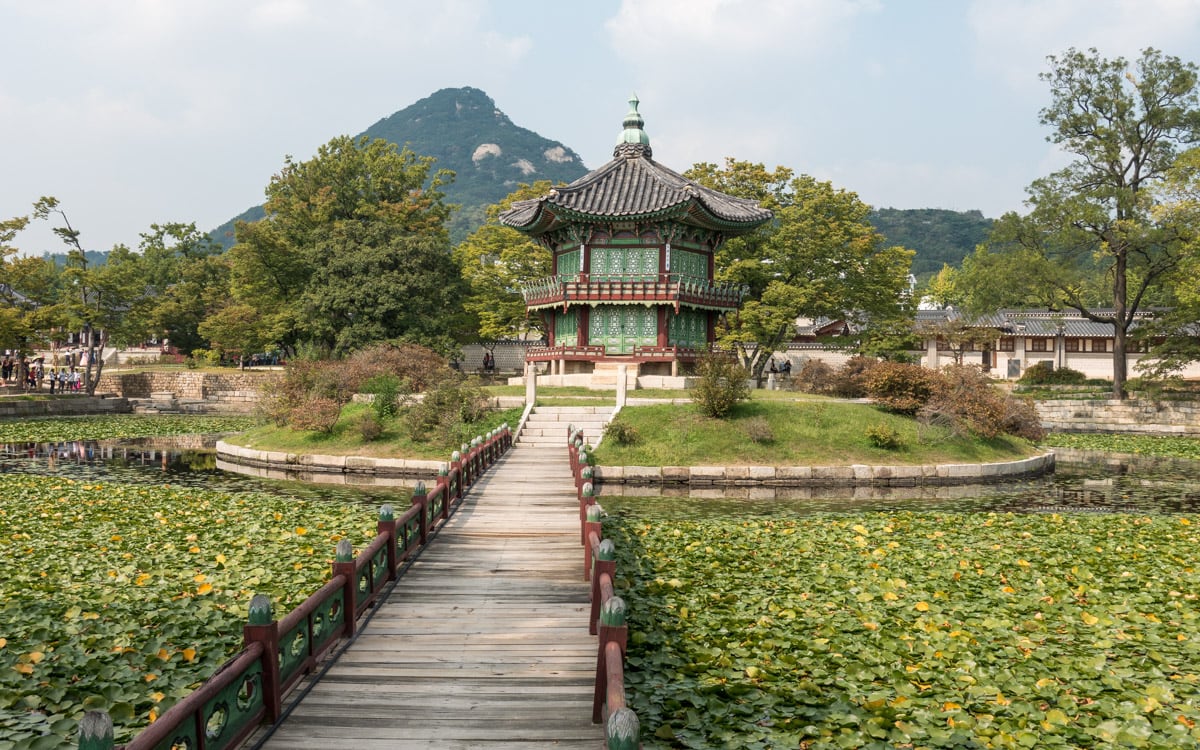
Hyangwonjeong Pavilion is a two story hexagonal pavilion built on a small island in the middle of a lake on the northern grounds of Gyeongbokgung Palace.
The beautiful pavilion was built on an artificial island in the middle of Hyangwonji pond by King Gojong during the 10th year of his reign in 1873. This was the same time Geoncheonggung Residence was being built.
The bridge, which allows private access to the island, is known as Chwihyanggyo Bridge. The original bridge was located on the opposite side of the island and was constructed only of wood. At the time, it was one of the longest wooden bridges.
During the Korean War, the bridge was destroyed. In 1953, Chwihyanggyo was rebuilt and moved to its current location as seen today.
National Folk Museum of Korea
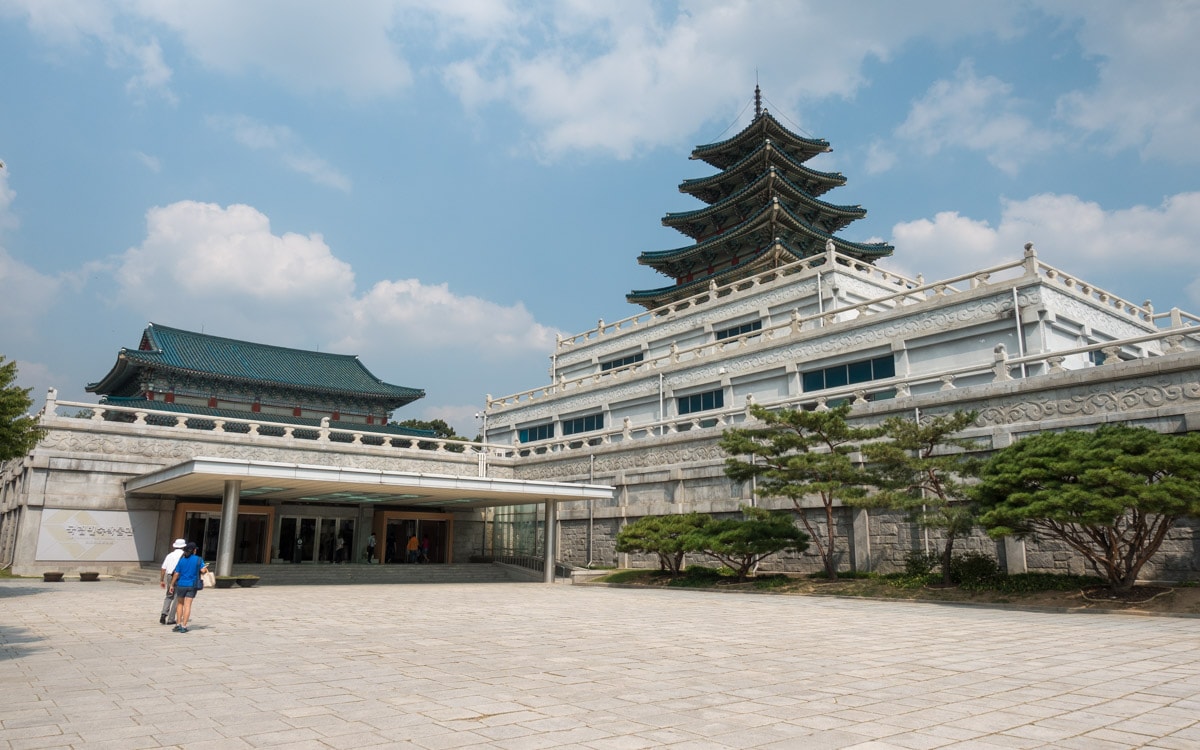
The National Folk Museum of Korea is a museum on the grounds of Gyeongbokgung Palace, not to be confused with the nearby National Palace Museum of Korea which is also found on the palace grounds.
The museum dates back to April 25, 1946. In 1975, the museum moved to the grounds of Gyeongbokgung Palace.
The museum moved to its current location on February 17, 1993. Today, it features over 4,000 artifacts on display which immerse visitors in the rich history.
Exhibits at this museum show the visitor how everyday citizens lived both past and present including the lifestyles and traditions of everyday Korean people during a time when the country was mainly agricultural.
Read more about the National Folk Museum of Korea.
National Palace Museum of Korea
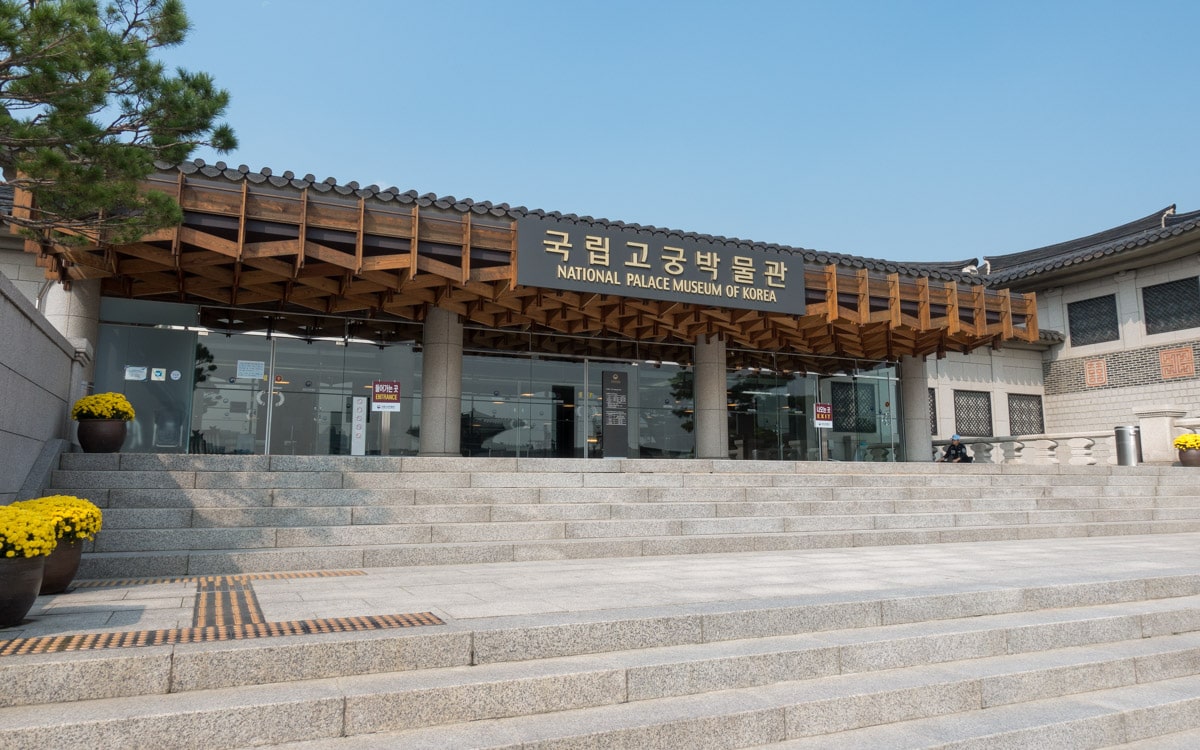
The National Palace Museum of Korea, located on the grounds of Gyeongbokgung Palace, houses a collection of over 900 relics and 40,000 artifacts from the royal court of Joseon Dynasty palaces including Gyeongbokgung, Changdeokgung, Changgyeonggung, and Jongmyo.
Originally, the museum was known as the Korean Imperial Museum when it opened on the grounds of Changgyeonggung in 1908.
Read more about the National Palace Museum of Korea.
Sinmumun Gate
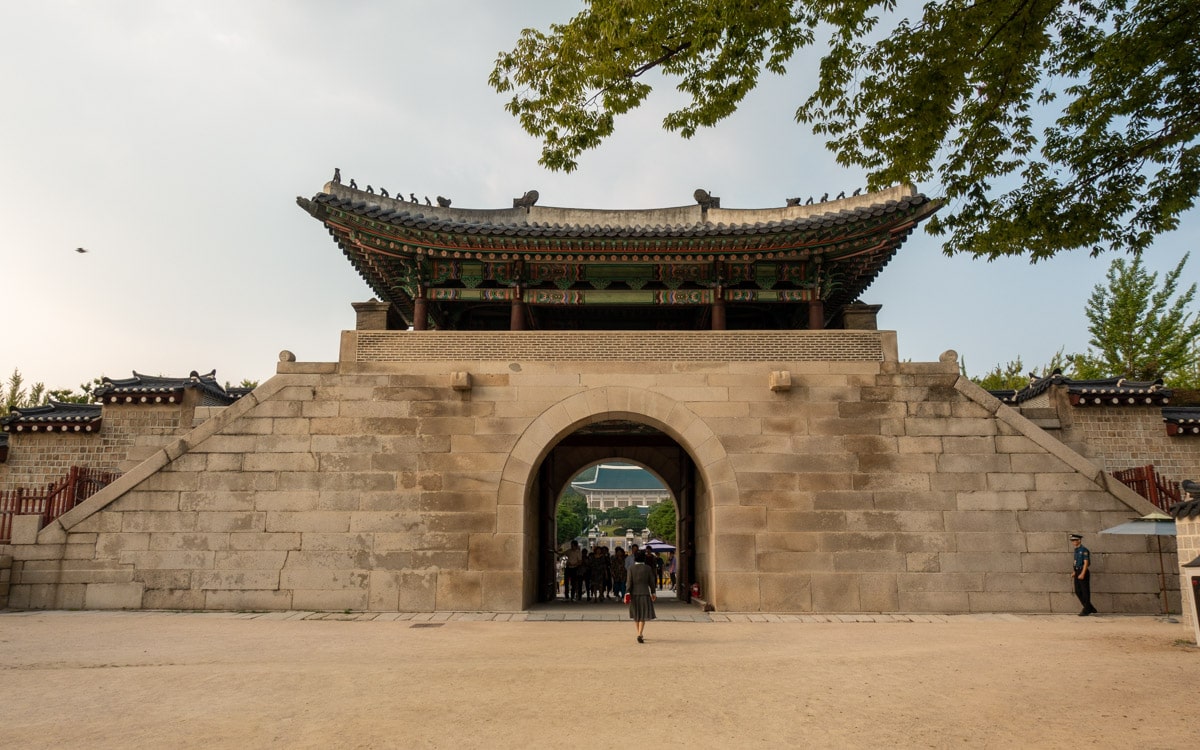
Sinmumun Gate, the northern palace gate, protected Gyeongbokgung Palace from attacks from the north. It features a single entrance and one story pavilion.
Construction on the stone gate first started in 1433 during the reign of King Sejong. He ruled from 1418 to 1450 as the fourth king of the Joseon Dynasty.
The gate was named in 1475 by King Seongjong.
Like many other structures, the gate was destroyed by the Japanese during their invasion in 1592.
The gate was not rebuilt until 1865. This was around the same time when the palace was being rebuilt by Prince Regent Heungseon Daewongun.
Sinmumun is one of four gates surrounding the palace. In total, the palace has 2,404 meters (7,887 feet) of walls. The other three gates are Gwanghwamun, Geonchunmun, and Yeongchumun.
The area was closed to the public from 1961 until 2006 because of security concerns due to its location near the Cheong Wa Dae (Blue House), the residence and office of the president of Korea.
Sujeongjeon Hall
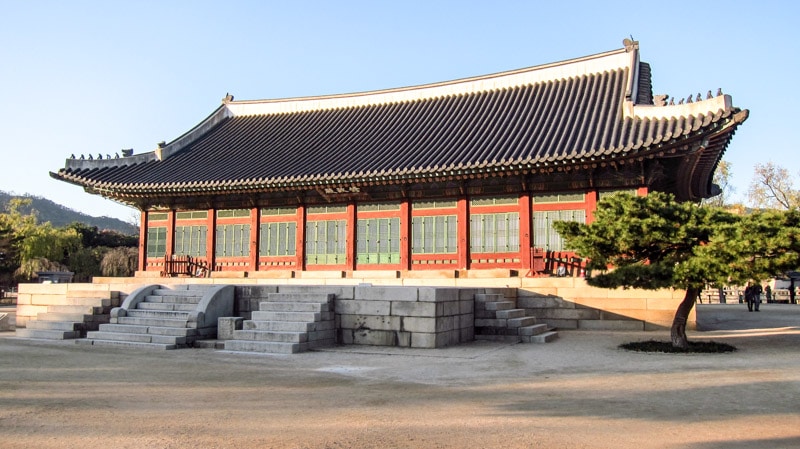
Sujeongjeon Hall was used as a sleeping quarter of the king and as a cabinet office during the Reform Movement of 1894.
Originally, the hall located here was known as Jiphyeonjeon or Hall of Worthies. The hall was built by King Sejong during his reign from 1418 to 1450.
It was here where Sejong developed the Korean Hangul writing system along with many other scholarly achievements. This period was known as the golden age of Korea.
Sujeongjeon Hall was rebuilt in 1867 during the reign of King Gojong (1863-1907). The hall was rebuilt at the same time as the restoration of Gyeongbokgung Palace. It was at this time when the name of the hall was changed to Sujeongjeon.
During his reign, Gojong used this Sujeongjeon Hall as his sleeping and residential quarters.
A double stone platform seen in front of the building was built out of respect for the king.
Yeongjegyo Bridge
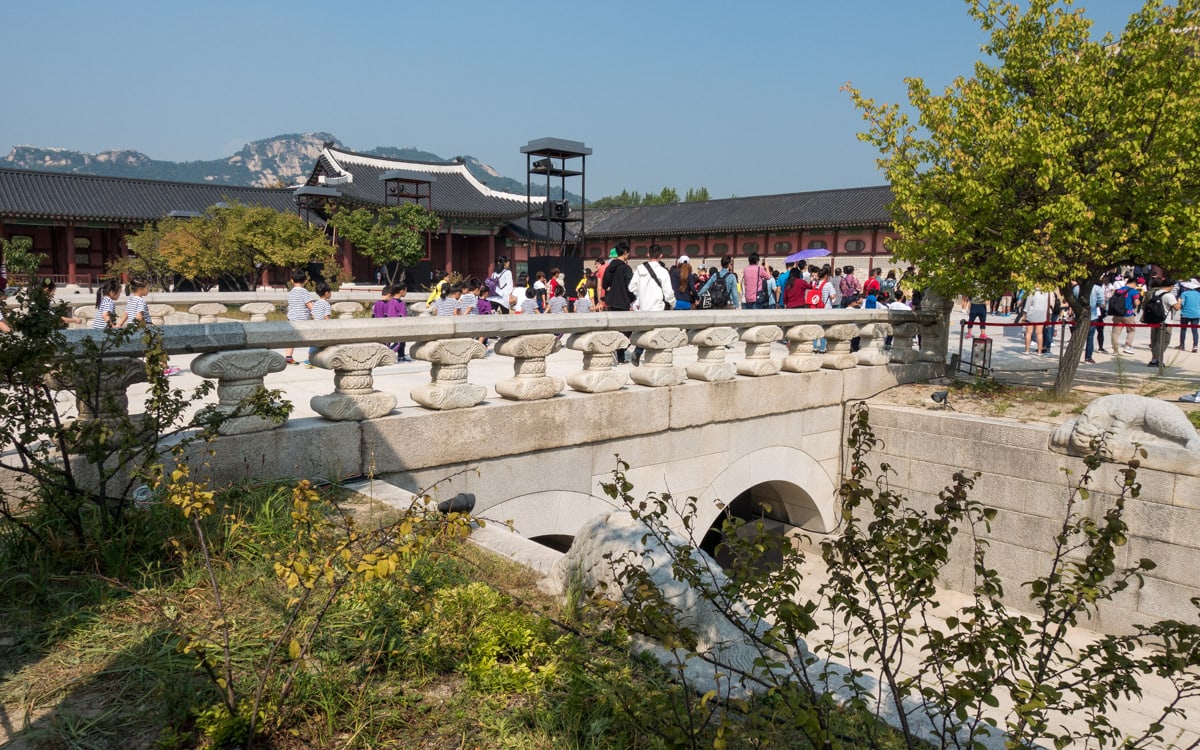
Yeongjegyo Bridge with two stone arches, is located just north of Heungnyemun Gate.
From 1926 to 1996, the Japanese General Government Building stood at this location. The building was the seat of the Governor-General of Korea who administered Korea under Japanese imperial rule. The building was demolished between 1995 and 1996.
The stream that runs underneath the bridge is known as Geumcheon. All Joseon royal residences had similar streams and bridges which symbolized purifying oneself before entering.
During meetings with the king, court officials used this location as a boundary to separate themselves from the king. The king would stand on one side of the bridge while his court officials would stand on the other side.
This area was considered a sacred space for the king with no other facilities nearby.
Gyeongbokgung Palace Information
Hours
March-October : 9:00-18:00
November-February : 9:00-17:00
Ticket office closes 1 hour before closing time.
Closed on Tuesdays
Admission
Adult : 3,000 won
Teenager : 1,500 won
Free guided tours in English are available at 11:00, 13:00, and 15:30. Meet at the information center next to the main entrance. Tours are also available in Japanese (10:00, 12:30, 14:30) and Chinese (10:30, 13:00, 15:00).
The Changing of the Guard ceremony takes place at 10:00, 11:00, 12:00, 1:00, 2:00, 3:00 between Gwanghwamun Gate and Heungnyemun Gate. The cost is free.
This palace is included with the Integrated Ticket Of Palaces.
Address
161 Sajik-ro, Jongno-gu, Seoul, South Korea
GPS Coordinates: 37.57824, 126.97706
How to Get Here
Option 1
Take Subway Line 3 to Gyeongbokgung Station (Exit 5).
Option 2
Take Subway Line 5 to Gwanghwamun Station (Exit 2).
Gyeongbokgung Palace Video
Map
Additional Resources
Viator by TripAdvisor
Viator is a popular online platform that helps travelers book tours, activities, and unique experiences worldwide, including in Seoul. It connects users with a wide selection of options – from sightseeing tours to cultural events and outdoor adventures – all offered by local providers.
Klook
Klook offers discounted tickets and reservations for various attractions and services in Seoul, from theme parks and museums to tours and transportation options.
Rakuten
Save money while exploring Seoul with Rakuten's cashback program. Book your hotels or other services through Rakuten and enjoy cashback rewards and exclusive deals.
If you sign up using the link below, you could earn $30 cashback on your first purchase over $30.
Book Recommendations
For an immersive guide to Seoul, many travelers choose to bring a book along. Fodor's Seoul, for example, offers detailed recommendations on sights, restaurants, maps, and travel tips.
Nearby Sights
Gwanghwamun Gate
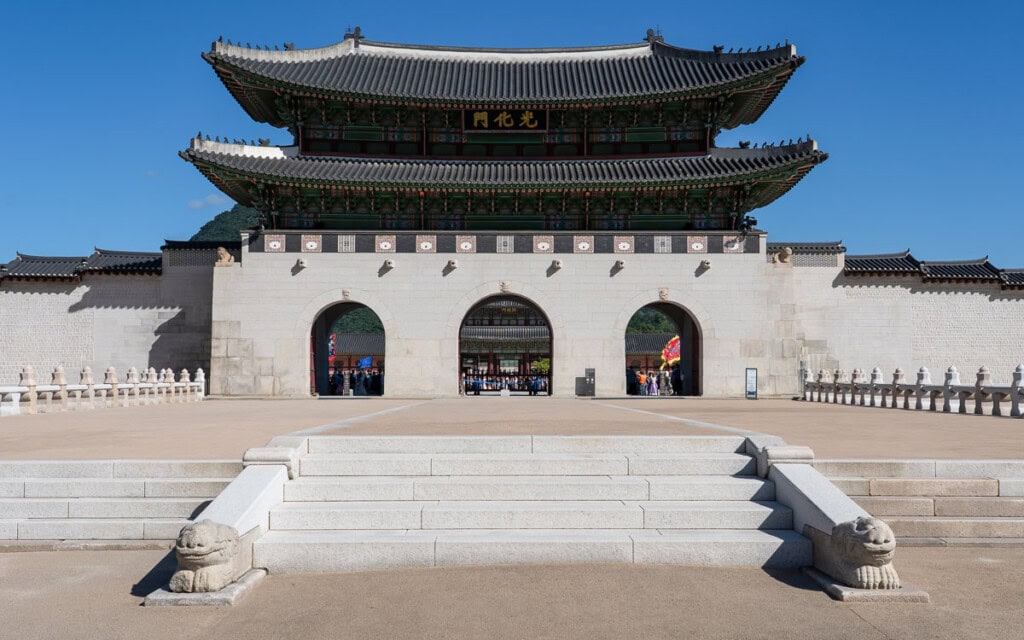
Gwanghwamun Gate is the imposing main gate of Gyeongbokgung Palace. The gate has been rebuilt many times over the years but remains an icon of Seoul. Construction began in 1395 at the beginning of the Joseon dynasty. The gate quickly became one of the most important gates of the Joseon Dynasty since it guarded the main palace.
National Palace Museum of Korea
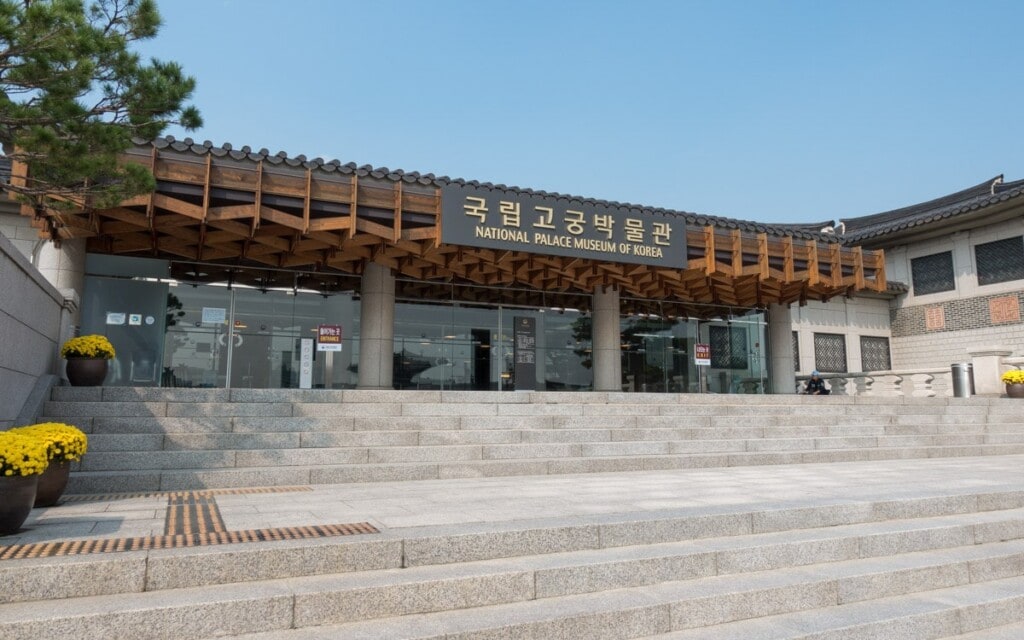
The National Palace Museum of Korea, located on the grounds of Gyeongbokgung Palace, houses a collection of over 900 relics and 40,000 artifacts from the royal court of Joseon Dynasty palaces including Gyeongbokgung, Changdeokgung, Changgyeonggung, and Jongmyo. Initially, the museum opened on the grounds of Changgyeonggung in 1908 and went by the name Korean Imperial Museum.
Gwanghwamun Square
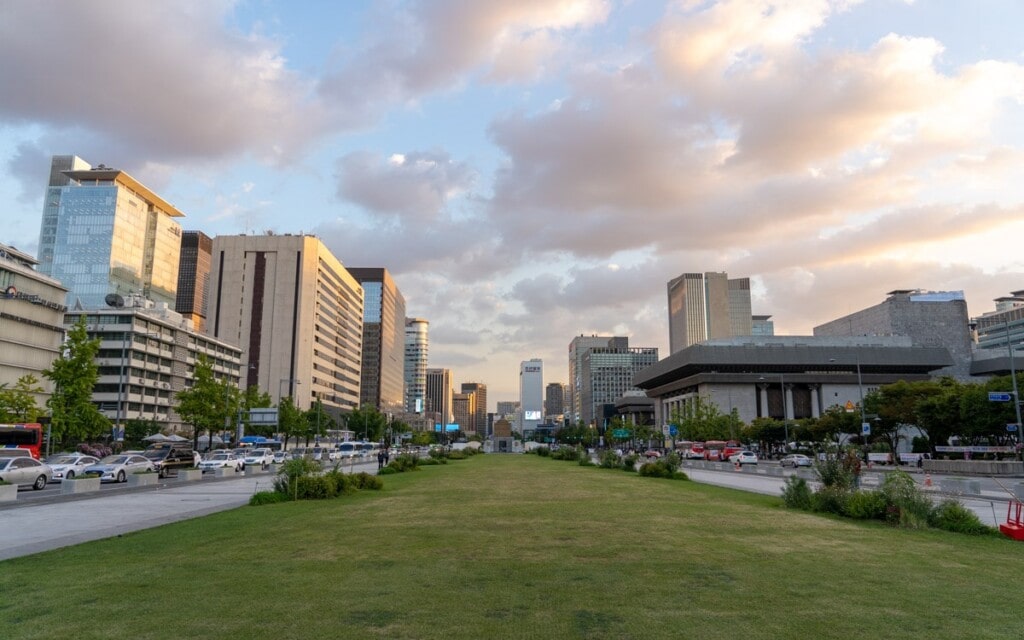
Gwanghwamun Square is a public area located in the heart of central Seoul that features museums, statues, restaurants, and beautiful surrounding views. Plans to convert the area into a pedestrian only square first surfaced in February, 2004. It was not until April, 23 2008 that construction began. Construction took 15 months at a cost of 44.5 billion won ($41,785,500).
National Folk Museum of Korea
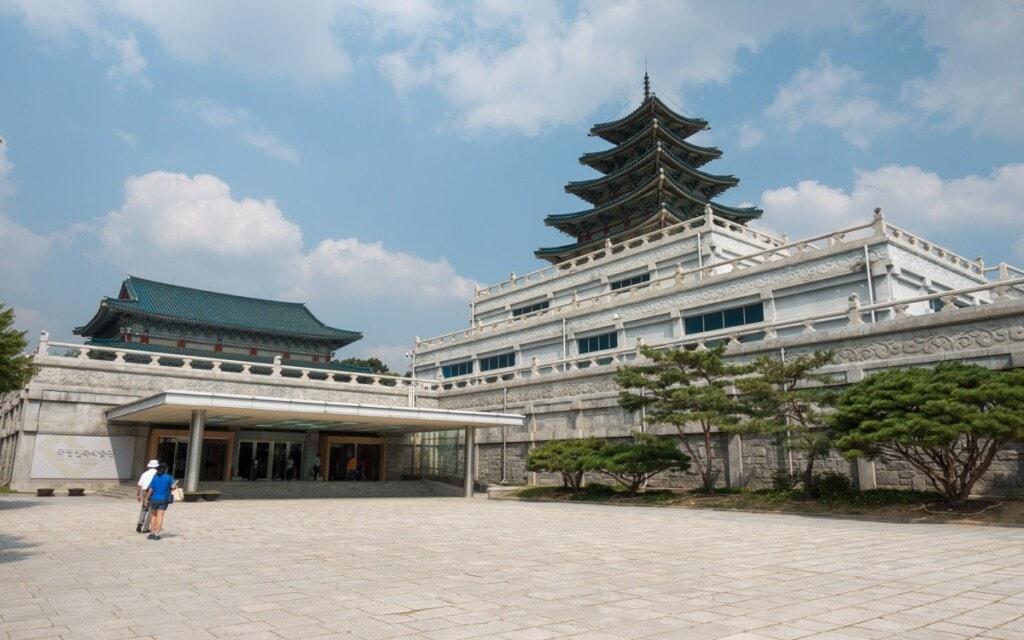
The National Folk Museum of Korea is a museum on the grounds of Gyeongbokgung Palace, not to be confused with the nearby National Palace Museum of Korea which is also found on the palace grounds. The museum dates back to April 25, 1946. In 1975, the museum moved to the grounds of Gyeongbokgung Palace.
Statue of King Sejong the Great
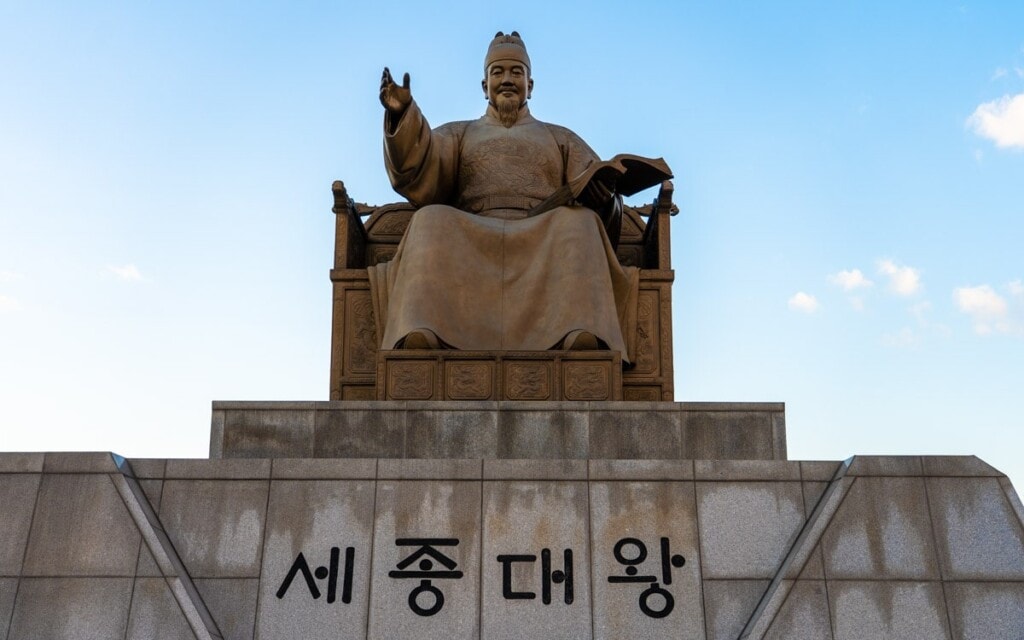
The Statue of King Sejong the Great is a golden statue located on Gwanghwamun Square in downtown Seoul near Gyeongbokgung Palace and Gwanghwamun Gate. This much respected fourth king of the Joseon Dynasty reigned from 1418 to 1450. Sejong was responsible for the creation of Hangul, the Korean alphabet, and other advancements in science, military, art, and politics.
Last Updated on Mar 20, 2025
